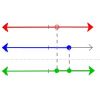Ages and Inequalities
Lesson Plans > Mathematics > Algebra > InequalitiesAges and Inequalities

One of the things a few of my students struggle with is understanding how phrases like "at least" or "no more than" convert into algebraic notation. Even if they understand what the various symbols mean, somehow the leap from the English language to math language stresses them out. I tell them that an easy way to figure it out is to think about their age. I tell them to fill in the blanks in the following sentence to make a true statement: "My age is _________ ____."
So, for example, if Hannah says to me, "Does 'at least' mean 'less than or equal to'?" I reply, "Hannah's age is at least ____."
She fills in a number that makes it true: "Hannah's age is at least three." From there, she is able to recognize that "at least" must be one of the "greater than" symbols instead of a "less than" because her age is clearly more than three.
From there, she can test whether the symbol includes equality by putting in her actual age: "My age is at least 15." Since this statement is also true, she knows that "at least" means "greater than or equal to."
It's seems like a very simplistic technique, but for students who struggle with this, simplistic works very well.
Here are some other examples:
My age is no more than 50.
My age does not exceed 50.
My age exceeds 3.
My age is at least 3.
My age is not above 50.
My age is below 50.
My age is not under 3.

